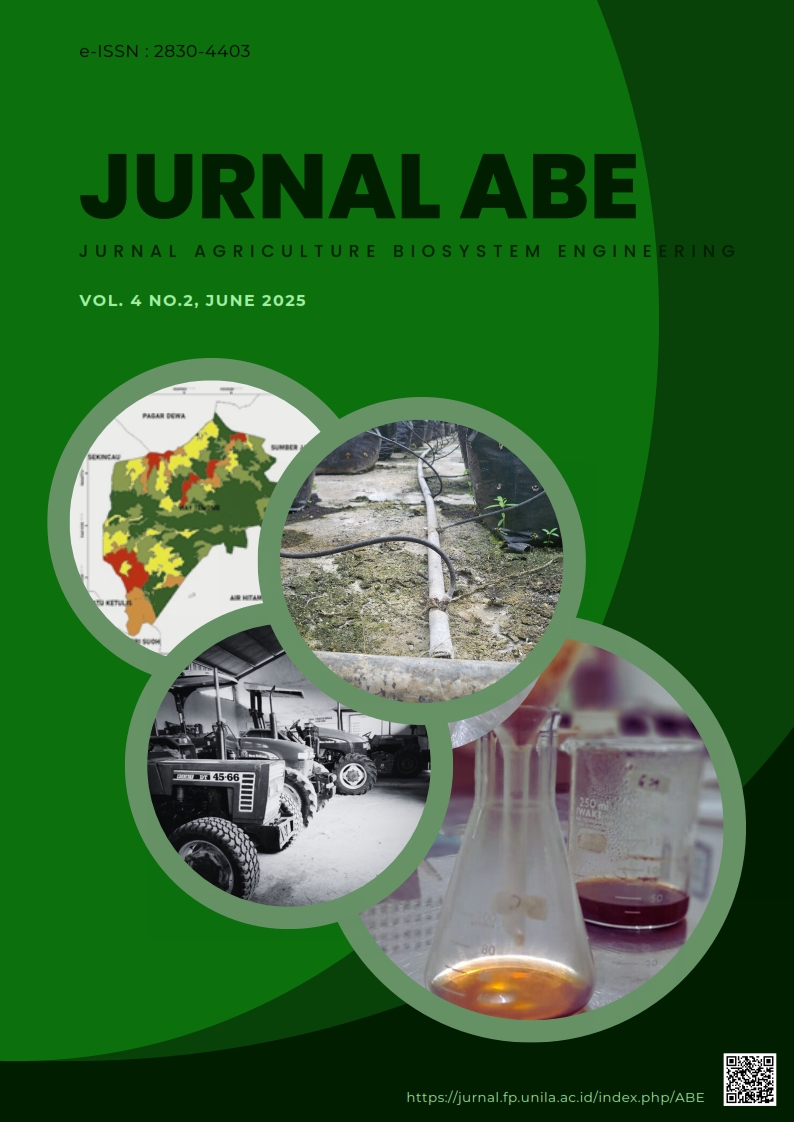Pengeringan Kacang Tanah Menggunakan Energi Panas Pembuangan AC
DOI:
https://doi.org/10.23960/jabe.v4i3.11596 Abstract View: 117
Abstract View: 117
Keywords:
Drying, Peanuts, AC condenser, Waste heat, Moisture contentAbstract
This study aimed to determine the effectiveness of the peanut drying process by utilizing waste heat from an air conditioner (AC) condenser, using two types of drying systems: horizontal and vertical heat flow. The results showed that the vertical heat flow dryer was more effective, achieving a consistent final moisture content of below 6% (in accordance with SNI 01-3921-1995) within 18 hours, with stable temperatures ranging from 38–40°C and RH below 50%. In contrast, the horizontal heat flow dryer resulted in uneven moisture content (3–14%) with less stable temperature and RH conditions. The drying rate constant (k) was higher in the vertical dryer, indicating a faster rate of water evaporation. Based on these findings, it can be concluded that waste heat from an AC condenser can be utilized as an alternative energy source. The vertical heat flow dryer is more efficient in reducing the moisture content of peanuts to meet storage quality standards.
Downloads
References
Alhafiz, R., Nurba, D., dan Devianti, D. 2022. Modifikasi Pengering Efek Rumah Kaca (ERK) Atap Parabolik untuk Kacang Tanah (Arachis hypogaeai L.). Jurnal Ilmiah Mahasiswa Pertanian, 7(2), 480-489.
Kashaninejad, M., Mortazavi, A., Safekordi, A., dan Tabil, L. G. 2007. Thin-Layer Drying Characteristics and Modeling of Pistachio Nuts. Journal of Food Engineering, 78(1), 98-108.
Khatir, R., Hartuti, S., dan Hardiyanti, U. 2022. Uji Performansi Alat Pengering Tipe Terowongan Hohenheim Aceh Dengan Aplikasi Proportional Integral Derivative Controller Untuk Kipas Outlet. Journal of Science and Technology, 15(3), 308-315.
Krokida, M. K., Karathanos, V. T., Maroulis, Z. B., dan Marinos-Kouris, D. 2003. Drying kinetics of some vegetables. Journal of Food Engineering, 59(4),391-403.
Lestari, N., Samsuar, S., Novitasari, E., dan Rahman, K. 2020. Kinerja Cabinet Dryer pada Pengeringan Jahe Merah dengan Memanfaatkan Panas Terbuang Kondensor Pendingin Udara. Jurnal Agritechno, 13(1), 57-70.
Mahlia, T. M. I., Cheng, L. W., Salikka, L. C. S., Lim, C. L., Hasan, M. H., dan Hamdani, U. 2012. Drying Garcinia Atroviridis Using Waste Heat from Condenser of a Split Room Air Conditioner. International Journal of Mechanical and Materials Engineering (IJMME), 7(2), 171-176.
Mentari, B., Nurba, D., dan Khathir, R. 2017. Penyulingan Minyak Atsiri Sereh Dapur (Cymbopogon Citratus) Dengan Metode Penyulingan Air-Uap. Jurnal Ilmiah Mahasiswa Pertanian, 1(1), 1009-1016.
Novianto, E. D., Pradipta, M. S. I., Suwasdi, S., Mursilati, M., dan Purnomo, S. B. 2020. Pemanfaatan Limbah Agroindustri Kacang Tanah Sebagai Media Pertumbuhan Mikrobia Probiotik Lactobacillus bulgaricus. AGRITEKNO: Jurnal Teknologi Pertanian, 9(1), 35-41.
Rahayuningtyas, A., dan Kuala, S. I. 2016. Pengaruh Suhu Dan Kelembaban Udara Pada Proses Pengeringan Singkong (Studi Kasus: Pengering Tipe Rak). ETHOS (Jurnal Penelitian dan Pengabdian), 4(1), 99-104.
Sembiring, M., Sipayung, R., dan Sitepu, F. E. 2014. Pertumbuhan Dan Produksi Kacang Tanah Dengan Pemberian Kompos Tandan Kosong Kelapa Sawit Pada Frekuensi Pembumbunan Yang Berbeda. Jurnal Online Agroekoteknologi, 2(2), 598-606.
Yuarni, D., Kadirman, K., dan Jamaluddin P, J. P. 2018. Laju Perubahan Kadar Air, Kadar Protein Dan Uji Organoleptik Ikan Lele Asin Menggunakan Alat Pengering Kabinet (Cabinet Dryer) Dengan Suhu Terkontrol. Jurnal Pendidikan Teknologi Pertanian, 1(1), 12-21.
Downloads
Published
How to Cite
Issue
Section
License
Copyright (c) 2025 Indah Puspitasari, Tamrin Tamrin, Winda Rahmawati, Warji Warji

This work is licensed under a Creative Commons Attribution-NonCommercial-ShareAlike 4.0 International License.
Authors who publish with this journal agree to the following terms:
Authors retain copyright and grant the journal right of first publication with the work simultaneously licensed under a Creative Commons Attribution-ShareAlike 4.0 International Lice that allows others to share the work with an acknowledgement of the work's authorship and initial publication in this journal.
Authors are able to enter into separate, additional contractual arrangements for the non-exclusive distribution of the journal's published version of the work (e.g., post it to an institutional repository or publish it in a book), with an acknowledgement of its initial publication in this journal.
Authors are permitted and encouraged to post their work online (e.g., in institutional repositories or on their website) prior to and during the submission process, as it can lead to productive exchanges, as well as earlier and greater citation of published work (See The Effect of Open Access).
Jurnal Agricultural Biosystem Engineering

JABE is licensed under a Creative Commons Attribution-ShareAlike 4.0 International License.




